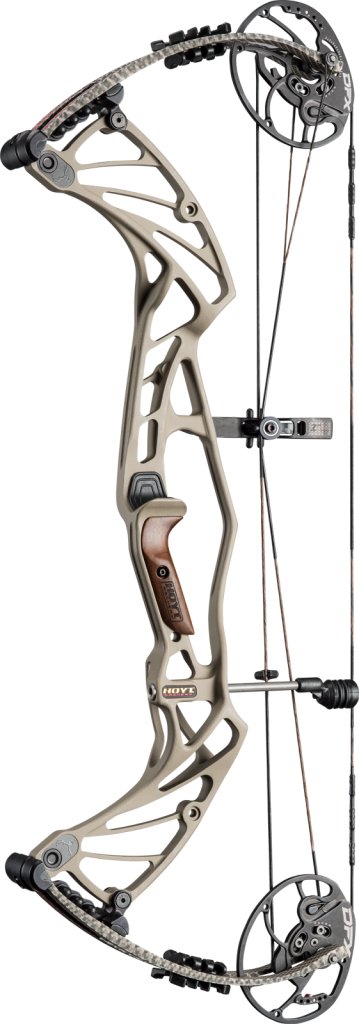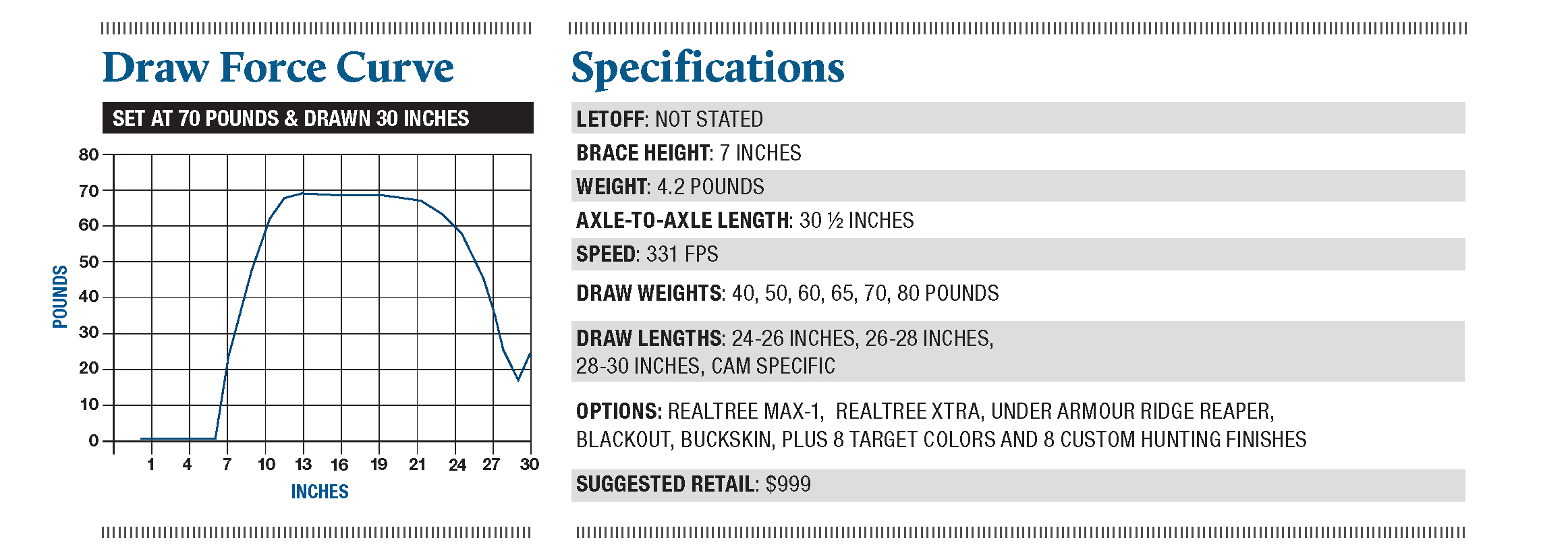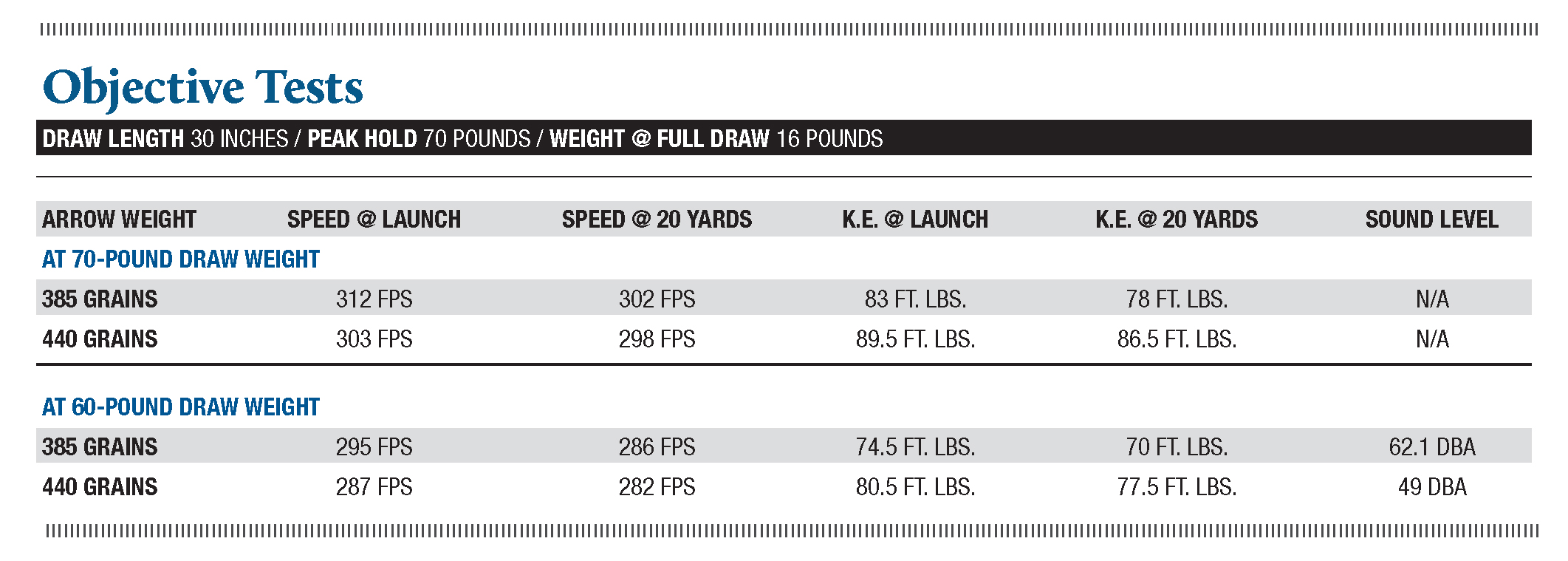Hoyt introduced its popular Defiant series last year in both aluminum and carbon versions, each version available as a Defiant, a Defiant 34 and a Defiant Turbo. As the names might suggest, the Defiant 34 is a longer axle-to-axle bow, and the Turbo is the fastest of the three.
 When the Defiant series was introduced last year, it boasted some spanking-new technology, the most significant being the DFX Cam and ½ system with attached UltraFlex limbs and a redesigned Pro-Lock Limb Pocket System for added stability. The DFX cams and pre-loaded UltraFlex limbs are uniquely designed in such a way that — relative to other bows — the string comes off each cam at a greater distance from the nock point. The result is a less sharp string angle, as well as better peep sight position for an improved, more comfortable shooting form. In effect, a compact 30 ½ -inch axle-to-axle bow offers the feel and performance characteristics of a 34-inch target bow. As I stated in last year’s review, that’s a big deal.
When the Defiant series was introduced last year, it boasted some spanking-new technology, the most significant being the DFX Cam and ½ system with attached UltraFlex limbs and a redesigned Pro-Lock Limb Pocket System for added stability. The DFX cams and pre-loaded UltraFlex limbs are uniquely designed in such a way that — relative to other bows — the string comes off each cam at a greater distance from the nock point. The result is a less sharp string angle, as well as better peep sight position for an improved, more comfortable shooting form. In effect, a compact 30 ½ -inch axle-to-axle bow offers the feel and performance characteristics of a 34-inch target bow. As I stated in last year’s review, that’s a big deal.
Some other proven and popular Hoyt features are retained in the 2017 Defiant bows, including the bridged riser design, Zero Torque Cable Guide, the Pro-Fit Grip and Hoyt’s Silent Shelf. What’s new, apart form the “Pro” appellation, is a slightly different riser geometry and the addition of the new Buckskin finish option.
The major difference between the carbon riser bows and the aluminum riser bows is about half a pound of weight. Carbon is stiffer and, theoretically at least, this makes it more stable. It also reduces vibration and noise, but, in this case, Hoyt’s aluminum riser bows are extremely low in noise and vibration, so the difference is marginal. Carbon does not transfer heat. This makes it warm to the touch even in the coldest weather. (If you think that is an insignificant advantage, you don’t hunt often in cold weather.) Is the extra cost worth it? That depends on your budget, on how important light weight is to you and on how often you hunt in cold weather.
As far as the differences between the various models, the Pro Defiant is the most compact at 30 ½ inches, and it has a respectable top speed of 331 fps. The Defiant 34 is 34 inches axle to axle, and has a slightly slower speed of 325 fps, while the Defiant Turbo is 33 inches axle to axle but attains an impressive top speed of 350 fps. The boost in speed is accounted for partly by a 6-inch brace height, as opposed to the 7-inch brace heights of the other two models, along with a slight modification of the DFX cams.
 In terms of appearance, the bow is distinctively Hoyt, with split limbs sporting Limb Shox limb dampeners and modestly understated logos (including one carved into the walnut grip). Fit and finish were flawless on the camo test bow, though I must admit I’m partial to the new Buckskin finish option with the carbon-weave pattern on the limbs.
In terms of appearance, the bow is distinctively Hoyt, with split limbs sporting Limb Shox limb dampeners and modestly understated logos (including one carved into the walnut grip). Fit and finish were flawless on the camo test bow, though I must admit I’m partial to the new Buckskin finish option with the carbon-weave pattern on the limbs.
Shooting The Bow
Setting up the bow was fairly straightforward. One of the bolts was extra tight on the draw-length module, requiring extra care not to strip it when adjusting draw length. The limb bolts are very smooth. (I like the larger limb bolts as found on Hoyt and some other bows, since they provide extra leverage if the bolts are tight, and there is very little risk of stripping them or busting a knuckle when the wrench slips out of the head.) Hoyt bows are justly reputed to be easy-tuning bows, and this one was tuned in a matter of minutes.
At just over 4 pounds, the Pro Defiant is not particularly heavy, but it is certainly not a feather. Balance is good. As the draw force curve indicates, the climb to peak weight is a little steep, but the overall cycle is so smooth this is hardly noticeable. It levels off after peak weight and drops into the valley with no hitches, bumps or wrenches at the wall. I found the twin cable stops more than adequate, but a limb stop is provided for shooters who prefer a rock-solid back wall. The Pro Defiant is a quiet bow — nearly as quiet as the carbon models. There is a detectable, but very small, amount of vibration at the shot. It’s a great bow for any bowhunter who puts a priority on shootability, overall quality and value over super light weight and carbon construction.
For more information, visit www.hoyt.com.






